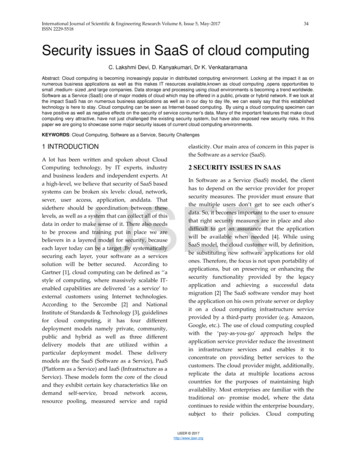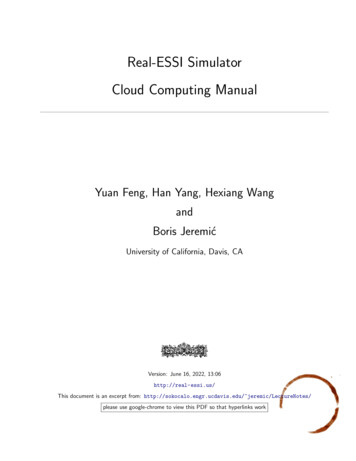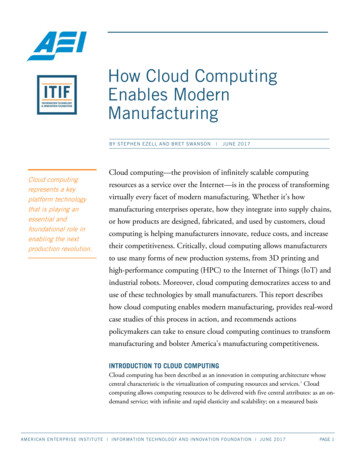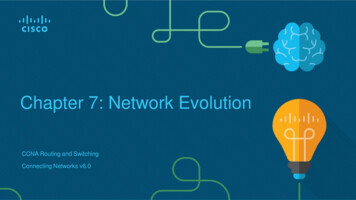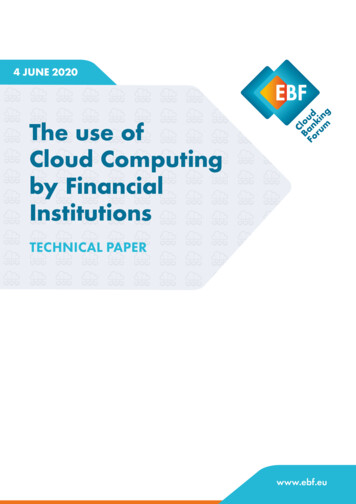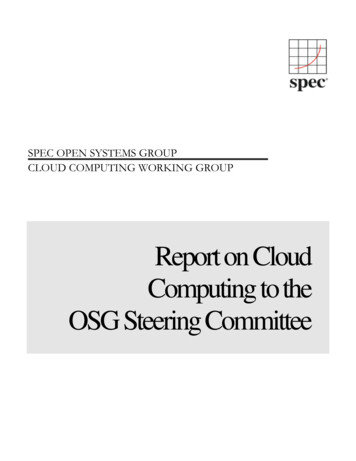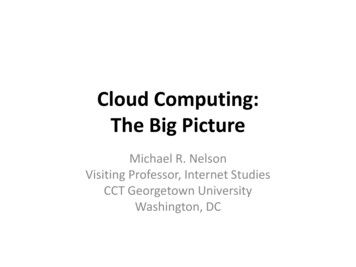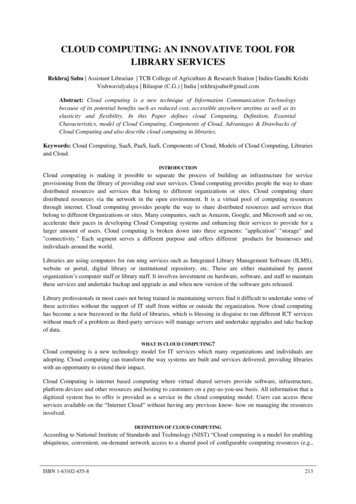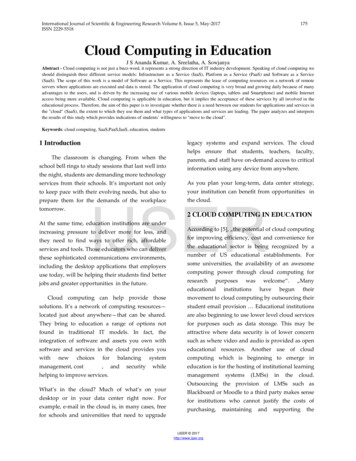
Transcription
International Journal of Scientific & Engineering Research Volume 8, Issue 5, May-2017ISSN 2229-5518175Cloud Computing in EducationJ S Ananda Kumar, A. Sreelatha, A. SowjanyaAbstract - Cloud computing is not just a buzz-word, it represents a strong direction of IT industry development. Speaking of cloud computing weshould distinguish three different service models: Infrastructure as a Service (IaaS), Platform as a Service (PaaS) and Software as a Service(SaaS). The scope of this work is a model of Software as a Service. This represents the lease of computing resources on a network of remoteservers where applications are executed and data is stored. The application of cloud computing is very broad and growing daily because of manyadvantages to the users, and is driven by the increasing use of various mobile devices (laptops, tablets and Smartphone) and mobile Internetaccess being more available. Cloud computing is applicable in education, but it implies the acceptance of these services by all involved in theeducational process. Therefore, the aim of this paper is to investigate whether there is a need between our students for applications and services inthe "cloud" (SaaS), the extent to which they use them and what types of applications and services are leading. The paper analyzes and interpretsthe results of this study which provides indications of students’ willingness to "move to the cloud".Keywords: cloud computing, SaaS,PaaS,IaaS, education, studentslegacy systems and expand services. The cloud1 IntroductionThe classroom is changing. From when theschool bell rings to study sessions that last well intothe night, students are demanding more technologyhelps ensure that students, teachers, faculty,parents, and staff have on-demand access to criticalinformation using any device from anywhere.services from their schools. It’s important not onlyAs you plan your long-term, data center strategy,to keep pace with their evolving needs, but also toyour institution can benefit from opportunities inprepare them for the demands of the workplacethe cloud.IJSERtomorrow.2 CLOUD COMPUTING IN EDUCATIONAt the same time, education institutions are underincreasing pressure to deliver more for less, andthey need to find ways to offer rich, affordableservices and tools. Those educators who can deliverthese sophisticated communications environments,including the desktop applications that employersuse today, will be helping their students find betterjobs and greater opportunities in the future.According to [5], „the potential of cloud computingfor improving efficiency, cost and convenience forthe educational sector is being recognized by anumber of US educational establishments. Forsome universities, the availability of an awesomecomputing power through cloud computing me“.have„ManybeguntheirCloud computing can help provide thosemovement to cloud computing by outsourcing theirsolutions. It’s a network of computing resources—student email provision Educational institutionslocated just about anywhere—that can be shared.are also beginning to use lower level cloud servicesThey bring to education a range of options notfor purposes such as data storage. This may befound in traditional IT models. In fact, theattractive where data security is of lower concernintegration of software and assets you own withsuch as where video and audio is provided as opensoftware and services in the cloud provides youeducational resources. Another use of cloudwithsystemcomputing which is beginning to emerge inwhileeducation is for the hosting of institutional learningnewchoicesmanagement, costfor,balancingandsecurityhelping to improve services.What’s in the cloud? Much of what’s on yourdesktop or in your data center right now. Forexample, e-mail in the cloud is, in many cases, freefor schools and universities that need to ng the provision of LMSs such asBlackboard or Moodle to a third party makes sensefor institutions who cannot justify the costs ofpurchasing,IJSER e
International Journal of Scientific & Engineering Research Volume 8, Issue 5, May-2017ISSN 2229-5518176hardware and software themselves“ [2]. CloudUsing services and applications in the cloud,computing is often associated with e-learning andstudents and teachers can achieve mobility ucationalresourcesandnecessaryenvironment mainly distributed on the cloud, inapplications are available via portable computerswhich Open Educational Resources were produced,and Internet connected devices. For example,researched and shared by participants worldwideclasses can be implemented outside the school /[3]. With applications in the cloud (SaaS), studentsfaculty or students can perform duties at variousand teachers can flexibly access their data via a webplaces.browser from a computer at home, school, library,student room or some other place, and achieverapid and efficient communication, collaboration,Figure 1 Example of Cloud-Based PersonalizedLearning Environmentexchange or share documents, contacts, notes,audio / video and other data. With their usestudents can create „CloudBased PersonalizedLearning Environment“ (Figure 1) [1]. "The firstidea that comes to mind when assessing such acloud space for learning, would be the creativeIJSERpotentials that could be nurtured i.e. the endlessideas, thoughts and knowledge that could beshared, created and inspired" [3]. In addition toindividual applications in the cloud, bundledapplications are also available (eg. Google Apps forEducation or Microsoft Live@edu with Office 365and other applications for Education) that combinetools for communication and collaboration, officetools for working with documents, and space tostore and synchronize data on demand. „Whereas a2.1 Cloud terminologyuniversity computing service department may aimServices include software and hardware, from e-to achieve 99.5% availability for its educationalmail to entire IT platforms, which are hosted in theservices such as the LMS, Google offers 99.9%cloud. This means that someone else makes themavailability for its educational application suite andavailable to you on demand—that is, when youappears to outperform this target „ [2].need them. Service capacity is controlled in thecloud and is dynamic and elastic: Computingresources are allocated and deallocated as demandA.Sreelatha, Dept. of MCA 2nd year, KMMIPS, Tirupati,mail id:adhurisree@gamil.com.A. Sowjanya, Dept. of MCA 2nd year, KMMIPS, Tirupati,changes.2.2 Cloud complianceMail id:adhurisree@gamil.com.Cloud services comply with relevant statutes, suchJ S Ananda Kumar, Assistant Professor, Dept. of MCA,Accountability Act of 1996 (HIPAA), the FamilyKMMIPS, Tirupati, mail id: lityandEducational Rights and Privacy Act (FERPA), andthe Schools Interoperability Framework (SIF).2.3 Defining the cloudIJSER 2017http://www.ijser.org
International Journal of Scientific & Engineering Research Volume 8, Issue 5, May-2017ISSN 2229-5518Clouds in nature may appear loosely defined, butattheNationalInstituteofStandardsandTechnology (NIST), cloud computing means thefollowing: On-demand service. You can get whatyou need when you need it. Broad network access. The cloud bringsnetwork-basedaccessto, andmanagement of, software and services—177Infrastructure as a Service (IaaS): The ondemand data centers.Outsourcing some capabilities to the cloud makes themost of what’s on-site by freeing time, budget, andpeople. For example, with SaaS, you can add services,like e-mail, affordably. With PaaS, you can deliverservices broadly without having to manage theinfrastructure. With IaaS, you get pay-as-you-go datacenter capacity for adding CPUs, storage, networking, orWeb hosting.meaning access is anywhere, anytime. Resource pooling. A large pool of esenvironmentallysustainable way. Flexible resource allocation. As demandsfluctuate, cloud services can scale rapidly.You don’t have to worry about bringingnewresources. IJSERserversonlineorreallocatingMeasured service. Most cloud usage ismetered, often per user or per hour. Withthose services, you pay for what you use.Microsoft offers Microsoft Live@edu, afree option designed specifically foreducation institutionsnothing proposition. With different types of cloudofferings, you have flexible options about whichservices to obtain in the cloud and which to keepon-site. Your priorities and security requirementsdetermine the level of cloud capabilities to explore.If you look closely at the cloud, you'll see threedistinct sets of ratingasThe cloud hosts the applications you use every dayeconomy, SaaS makes sense. It can lower expensesassociated with software acquisitions in the nearterm. Longer term, it helps organizations withlimited IT resources to deploy and maintain neededsoftware in a timely manner while, at the sametime, reducing energy consumption and expense.A growing number of academic institutions areturning to SaaS for their desktop applications. Forexample, Hinds Community College uses an e-mailapplications, such as e-mail, people use 3.1 Anytime, anywhere apps: SaaSprocessing, and more. In the current and futureThe choice to move to the cloud is not an all-or-SoftwareSaaS, PaaS, and IaaSfor productivity, contact management, payment3 Which cloud is right for you? Figure 2 The three general types of cloud services:aServiceenvironmentapplications run.(PaaS):inThewhichsolution hosted in the cloud. Students now have thefree collaboration tools they want, people oncampus have the tools they need to work together,and administrators are finding it easier and morecost-effective to manage.3.2 SaaS for education: Microsoft Live@eduIJSER 2017http://www.ijser.org
International Journal of Scientific & Engineering Research Volume 8, Issue 5, May-2017ISSN 2229-5518178The workplace is changing, and the desktopprovider maintains and updates in its data centers.applications that employers use today will evolveYou can also use PaaS to create multi-tenantto desktop applications combined with Webapplications—that is, services accessed by manyservicesusers ’s workforce want to partner withcompanies that can give them affordable access toWith PaaS, you can develop new applications orthose tools today.services in the cloud that do not depend on aMicrosoft Live@edu is a program that provideswidely available to users through the Internet.students, staff, faculty, and alumni long-term,PaaS delivers cloud-based application developmentprimary e-mail addresses and other applicationstools in addition to services for testing, deploying,that they can use to collaborate and communicatecollaboratingonline—all at no cost to education institutions.applications. The accessibility of PaaSspecific platform to run, and you can make themon,hosting,andmaintainingofferingsStudents will be using Microsoft products similar toenables any programmer to create enterprise-scalethose used in many workplaces that help to preparesystems that integrate with other Web services andthem for jobs after college.databases—an aspect of cloud computing thatfosters additional opportunities for education ITand allows bigger thinking.IJSERFigure 3 Education of Cloud in SaaS3.3 Platforms in the cloud: g how academic institutions thinkabout how they serve their students, teachers,faculty, and staff. Size—of your service, budget, orstaff—does not limit IT when the platform forcustom services is as readily available and broadlydeployable as the Web. Cloud platforms free you tofocus on the services you can offer withoutworrying about or managing the infrastructureneeded for those services.PaaS is the operating environment of the cloudwith the tools you need on demand to create andhost online services, software, Web sites, andmobileapplications.WithPaaS,youcanconcentrate on delivering applications rather thanon the underlying infrastructure, which a serviceFigure 4 Education of Cloud in PaaSThe open architecture of PaaS can erability with on-site systems—importantconsiderations because education operates in amixed IT world. Interoperability gives you theflexibility to take advantage of cloud benefits whileretaining data and applications on-site as needed.3.4 Data centers on demand: IaaSHow many data centers does it take to run aK 12 or higher education institution? Now that thecloud offers storage, networks, and servers as aservice, technology is no longer bound by thetraditional on-site IT department. On-demand dataIJSER 2017http://www.ijser.org
International Journal of Scientific & Engineering Research Volume 8, Issue 5, May-2017ISSN 2229-5518179centers put virtually unlimited computing poweraddition, these institutions must comply withinto the hands of even the smallest educationregulatory statutes, such FERPA and HIPAA, andinstitution.should support education standards, such as SIF.On-demand data centers—also known as IaaS—NIST likens the adoption of cloud computing toprovide compute power, memory, and storage,wireless technology. Institutions learned how totypically priced per hour according to resourceprotectconsumption. Some call IaaS bare metal onforward—and they will do the same with clouddemand. You pay for only what you use, and thecomputing. In building its solution, Aga Khanservice provides all the capacity you need, butUniversity in Pakistan found that cloud computingyou’re responsible for monitoring, managing, andhelped strengthen security and improve protectionpatching your on-demand infrastructure. One bigagainst viruses, resulting in 66 percent reduction inadvantage of IaaS is that it offers a cloud-basedcalls to the IT department.theirwirelessdataastheymoveddata center without requiring you to install newequipmentortowaitforthehardwareprocurement process. This means you can get ITresources at your school, college, or university thatotherwise might not be available.5 Cloud benefits for educationHow can the cloud help you transform education?Consider the following:IJSERWith IaaS, savings come from hardware and data services in the cloud that students,infrastructure costs but not necessarily fromteachers, faculty, and staff can reuse.staffing because you are still responsible for systemmanagement, patch management, failover andbackup,redundancy,andothersystemOffer your own data mashups on a portal. Infrastructure. Get all the IT resourcesyou need, only when you need them,management tasks. Depending on the service, anmanaged securely and predictably. AndIaaS provider typically handles load balancing,pay for only what you use. Any budgetmonitoring, and scaling automatically, and youmanage your cloud deployments.Flexible services. Drive innovation withconstrained institution has to like that. Applications and content. Rather thanwaiting in the software procurement line,gethostedsoftware,datasets,andservices so fast you’ll have plenty of timeto work on your mission. Policiesandregulations.Proceedcarefully, but note how cloud computingcan help you meet your institution’scompliance requirements. Figure 5 Education of Cloud in IaaSCreative IT. Free your IT departmentfrom a keep-the-lights-on approach tofoster some creative problem solving that4 Security in the cloudcan help teachers better engage theirstudents.Education institutions are entrusted withconfidential information and private data. Cloudcomputing may seem risky because you cannot secureits perimeter—where are a cloud’s boundaries? InIJSER 2017http://www.ijser.org
International Journal of Scientific & Engineering Research Volume 8, Issue 5, May-2017ISSN 2229-5518180[5] Sultan, N., Cloud computing for education: A m/science/article/pii/S0268401209 001170 (28. 01. 2013)Figure 6 Cloud benefits for education6 CONCLUSIONThe cloud allows us to access our work anywhere,anytime and share it with anyone. It frees us fromIJSERneeding a particular machine to access a file or anapplication like a word processor or spreadsheetprogram. In the present paper a cloud educationsystem is introduced and how it is beneficial forstudents, faculty and the educational institutes forproviding quality education.REFERENCES[1] Al-Zoube, M., E-learning on the Cloud, InternationalArab Journal of e-Technology, Vol.1, No.2, 2009,http://www.iajet.org/iajet/iajet files/vol.1/no.2/ELearning%20on%20the%20Cloud.pdf (28. 12. 2012)[2] Cloud Computing in Education, IITE Policy ications/en/files/3214674.pdf (29. 01. 2013)[3] Kop, R., Carroll, F., Cloud Computing andCreativity: Learning on a Massive Open Online Course,European Journal of Open, Distance and E-Learning,2011, http://www.eurodl.org/index.php?article 457 (21.01. 2013)[4] Mallikharjuna Rao, N., Sasidhar, C., SatyendraKumar, V., Cloud Computing Through Mobile Larning,International Journal of Advanced Computer Scienceand Applications, Vol.1, No. 6, December 2010,http://thesai.org/Downloads/Volume1No6/Paper 7 Cloud Co mputing Through Mobile-Learning.pdf (28. 01.2013)IJSER 2017http://www.ijser.org
example, Hinds Community College uses an e-mail solution hosted in the cloud. Students now have the free collaboration tools they want, people on campus have the tools they need to work together, and administrators are finding it easier and more cost-effective to manage. 3.2 SaaS for education: Microsoft Live@edu . IJSER




